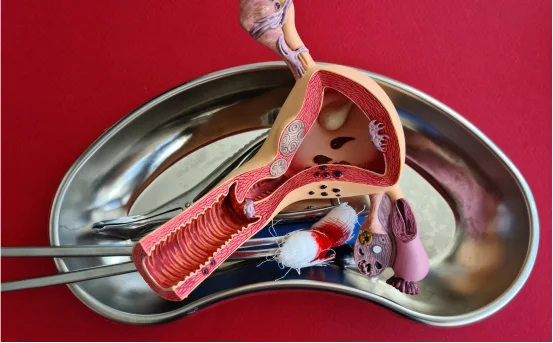Endometrial ablation is a minimally invasive medical procedure designed to treat abnormal uterine bleeding in women. It works by removing or destroying the lining of the uterus, known as the endometrium, to reduce or stop excessive menstrual bleeding. This procedure is typically recommended for women who have heavy periods that have not responded well to medications or hormonal therapy, and who no longer wish to have children.
Endometrial ablation is a safe and effective treatment used to reduce or stop heavy menstrual bleeding by targeting the lining of the uterus (endometrium). It’s a preferred alternative to more invasive procedures like hysterectomy, especially for women who want symptom relief without undergoing major surgery. The procedure is especially suitable for those who have completed childbearing and are looking for a way to regain control over their menstrual cycles and daily life.
What is Endometrial Ablation?
The endometrium is the inner lining of the uterus that thickens and sheds during the menstrual cycle. In some women, this lining grows excessively or does not shed properly, resulting in abnormal uterine bleeding. This can cause symptoms like heavy periods (menorrhagia), prolonged bleeding, clotting, and anemia.
Endometrial ablation involves removing or destroying the endometrial tissue using various techniques. Once the lining is removed, scar tissue forms inside the uterus, reducing or stopping menstrual flow. While the procedure can greatly improve quality of life, it is not a method of contraception and is only recommended for women who do not wish to become pregnant in the future.
Who Can Benefit from Endometrial Ablation?
Endometrial ablation is recommended for women experiencing
-
Heavy menstrual bleeding (menorrhagia) :- Periods that last longer than seven days or involve passing large blood clots.
-
Irregular menstrual cycles :- Bleeding that occurs too frequently or unpredictably.
-
Bleeding that leads to anemia :- Causing fatigue, weakness, or shortness of breath.
Doctors usually recommend trying medications or hormonal therapy first. Endometrial ablation becomes an option when these methods fail to control excessive bleeding. Importantly, it is not suitable for women who are pregnant or planning future pregnancies, as pregnancy after the procedure can be risky.
Types of Endometrial Ablation Procedures
Several techniques are used to perform endometrial ablation, all aimed at destroying the uterine lining. The choice depends on your medical condition, the size of your uterus, and the equipment available at the hospital.
- Thermal Balloon Ablation :- A balloon filled with hot fluid is inserted into the uterus. The heat destroys the endometrial lining.
- Radiofrequency Ablation :- A device releases radiofrequency energy to remove the uterine lining quickly and efficiently.
- Cryoablation (Freezing) :- Instead of heat, extreme cold is used to destroy the endometrial tissue.
- Microwave Endometrial Ablation :- Microwave energy is applied through a thin wand to destroy the lining of the uterus.
- Electrosurgical Resection :- A hysteroscope is used to remove or vaporize the endometrium using an electrical current.
All of these procedures are generally outpatient treatments, meaning you can go home the same day. They are minimally invasive and often performed under local or general anesthesia, depending on the method.
Preparing for Endometrial Ablation
Before undergoing endometrial ablation, your gynecologist will conduct a series of evaluations, which may include
-
Pelvic examination and ultrasound to assess the shape and size of your uterus.
-
Endometrial biopsy to rule out cancer or other abnormalities.
-
Pregnancy test, since the procedure is not performed during pregnancy.
You may also be given medication to thin the endometrial lining before the procedure, which helps improve results.
The Endometrial Ablation Procedure
Endometrial ablation typically takes 30 to 45 minutes and does not require any major incisions. Here is a step by step overview
-
You will receive local, regional, or general anesthesia to ensure comfort.
-
The doctor inserts a hysteroscope or a special device into the uterus through the cervix.
-
The chosen method heat, cold, microwave, or radiofrequency is used to destroy the endometrial lining.
-
After the procedure, you are monitored for a short period before being discharged.
Most women return home the same day and can resume light activities within 1–2 days.
Recovery After Endometrial Ablation
Recovery from endometrial ablation is usually quick, but some mild side effects are common, such as
-
Cramping or pelvic discomfort for 1–2 days
-
Watery or blood tinged vaginal discharge for a few weeks
-
Temporary frequent urination or nausea in some cases
You should avoid sexual intercourse, tampons, or douching for at least 2 weeks or as advised by your doctor to allow proper healing.
Most women notice a significant reduction in menstrual bleeding within 2–3 months after the procedure. In some cases, periods may stop completely.
Risks and Considerations
While endometrial ablation is generally safe, there are some risks and limitations to consider
-
Infection or bleeding
-
Perforation of the uterus (rare)
-
Injury to surrounding organs if energy devices are used
-
Scar tissue formation inside the uterus (Asherman’s syndrome)
It is also important to note that pregnancy after endometrial ablation is unsafe and can lead to serious complications. Therefore, a reliable form of contraception is recommended if you are sexually active.
Success Rate and Long Term Results
Most women experience a 70–90% reduction in menstrual bleeding, and some stop having periods altogether. The success of the procedure depends on
-
The cause of abnormal bleeding
-
Age and hormonal status
-
Whether other uterine conditions, like fibroids, are present
In some cases, additional procedures or hysterectomy may be required if bleeding continues or returns after a few years.
When to Consult Your Doctor?
You should contact your doctor immediately if you experience
-
Heavy bleeding that does not reduce over time
-
Severe abdominal pain or cramping
-
Fever, foul smelling discharge, or signs of infection
Prompt evaluation ensures any rare complications are addressed quickly.
Conclusion
Endometrial ablation is an effective and minimally invasive solution for women struggling with abnormal uterine bleeding who no longer plan future pregnancies. By removing or destroying the endometrial lining, this procedure can significantly improve quality of life, reduce the need for medications, and help avoid more invasive surgeries like hysterectomy.























